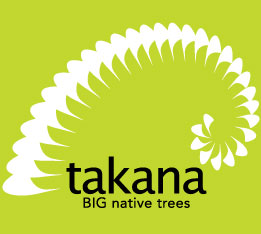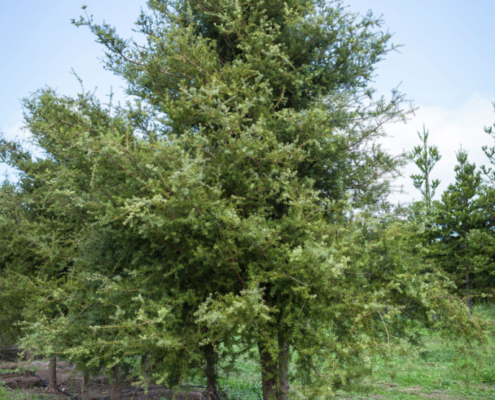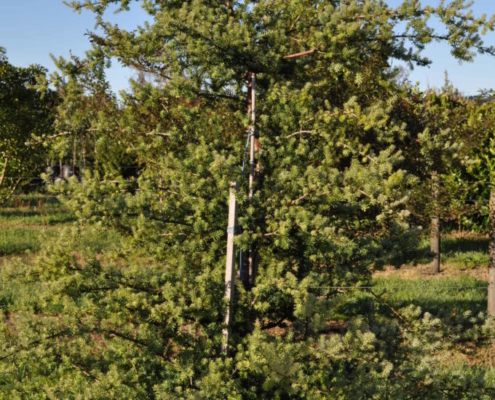Totara (Podocarpus totara), and his two brothers, (Podocarpus totara aureus) and (Podocarpus totara matapouri blue)
Tree in your eye time! Enjoy a slightly longer two minutes with one of our most majestic native trees, Totara (Podocarpus totara), often referred to as true Totara in order to avoid confusion with Hall’s Totara, a much thinner-skinned, smaller species. The oldest Totara in the country is between 1400-1850 years old, longevity being a principal characteristic of Totara. This living specimen has been named, Pouakani, and grows near the Pureora Forest at a magnificent 39m tall, with the trunk at breast height, a lordly 3.63m. To the first fork, the trunk is 10.36m. Despite this species’ ability to attain extraordinary dimensions, on exposed coastal sites a Totara might achieve only the height of a low spreading shrub.
Generally a lowland species, Totara is endemic throughout the country. It’s often found in lower sub-alpine and montane forest, but also regenerating on farmland from seed dispersed by birds. The fibrous dark brown bark is stringy and can be stripped from the tree in large sections without damage to the tree. 2cm long coriaceous sharply pointed leaves dissuade stock from browsing on the foliage.
In spring, wind disperses pollen. The male tree produces yellowish cone-like catkins, and in October and November the female generates 3.5mm green-turning-bright-red or orange fruit with a green seed connected to it. Between March and mid-May the seed matures and drops or is dispersed by kereru, bellbirds, tui, waxeyes, blackbirds, starlings, and thrushes. Fruit takes a year to mature and all stages of reproduction may be simultaneously found on a single tree. Fruiting is more abundant in some years.
For sites where height and longevity are desirable, Podocarpus totara is a robust iconic New Zealand spreading specimen tree. It is dioecious and grows fast to 4m within ten years to a maximum of 30m. The sapling is slender, but matures into an attractive robust tree which can be trimmed as hedging, or formed into effective shelter belts with stock-resistant foliage to the ground. While tolerant of dry conditions and seasonal drought, Totara will likely develop poor form and proportions on wet deprived soils, preferring young fertile ground for optimum development. Totara is light-seeking and will grow a single leader until it reaches the canopy and then spread.
Several cultivars for garden use include Podocarpus totara aureus, a spreading specimen with softer yellow-gold foliage. Aureus is dioecious and grows to 3m within ten years up to 10m. The foliage becomes more golden with exposure to sun. This hardy cultivar is drought and frost tolerant and makes great hedging and an ideal topiary subject.
Podocarpus totara matapouri blue, another popular cultivar, is a beautiful spreading specimen with softer rich blue glaucous foliage. It grows steadily to 3m within ten years to a maximum of 10m. It is hardy, drought and frost tolerant, and dioecious. This Totara cultivar also makes beautiful hedging and lends itself to topiary.
Totara (Podocarpus totara)
Totara Golden (Podocarpus totara aureus)
Totara Blue (Podocarpus totara matapouri blue)
Totara magic and medicine for a few minutes more
Totara heartwood is accorded higher quality than Californian redwood, and for specific uses outshines kauri heartwood as well. Totara heartwood is the most naturally durable native timber in contact with the ground. It is borer resistant, and will retain full integrity indefinitely when used above ground. In salt water it retains integrity and is better equipped to fend off Teredo and shipworm than other native species.
- The wood is finely textured, effortlessly worked, and controllable in machining. It can be smoothly cross-cut, and finishes reasonably well with a coating of oil or wax.
- The extraordinarily straight grain splits willingly and when dried, the reddish-brown heartwood offers excellent dimensional stability. Sapwood is pale brown.
- Maori so revered Totara that they named it chief of the ‘company of superior and lordly trees.’ Magnificent specimens became heirlooms and bloodshed wasn’t uncommon in dispute over them.
- From one log of a coveted specimen Maori could carve a 24m war canoe. Traditional Maori boat building took advantage of Totara’s comparable light weight, 25% lighter than kauri, the long linear timber, and the wood’s natural oils protecting it from rot.
- While ideal timber for general building, Totara wasn’t the best for long beams because once dried, it became brittle and was prone under load to suddenly fail.
- Totara was specifically sourced for Maori carvings
- Europeans also appreciated Totara’s durability and used it for railway sleepers, floor piling, fence posts, and many other applications.
- Totara bark’s stringiness led to a convenient use in making bags to carry preserved birds. It was also a popular house-covering.
- The tree was also sought after medicinally by Maori and later, Europeans. Totara bark and wood contain diterpenes, including totarol, dimer podototarin, podocarpic acid, and tannins.
- Totarol is a strong antioxidant, antibacterial, anti-inflammatory, and a preservative and the extract is much lauded today. Trees need to be 150-200 years old in order to have developed these compounds.
- The inner bark boiled with mānuka and let stand for a week was used by Maori to reduce fever. An infusion of leaves was used to sort out stomach problems. Wood smoke aided piles, skin disease, and venereal disease in women.
- The bark could be used for water vessels, and splints, and was often the hard stick in friction fire-starting.
- Totara fruit is edible and Maori men climbed the trees to harvest it, however it has a definite turpentine flavour.
- Totara’s pointy foliage makes it a useful security device
- Seeds may be collected by hand from the lower branches of smaller trees from mid-March to May, and by late autumn, fallen seeds have turned brown and detached from the fruity receptacles (arils) and can be harvested from the ground.
- Mimicking fallen seed on the forest floor, damp cool stratification of the seed for several weeks may enhance germination. Seeds can be viably stored for 6-18 months.
- Sow seed in spring for a six week germination period, although it can take up to a year in the wild, dependent on the growing medium.
- Totara can also be propagated from semi-hardwood cuttings taken in early to mid-April, and treated with semi-hardwood hormone before leaving them under mist spray in a greenhouse.
- Prefers full sun or partial shade and rich soil






